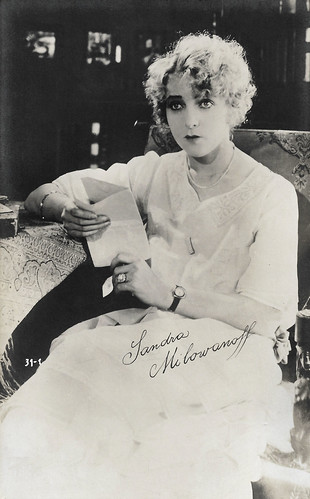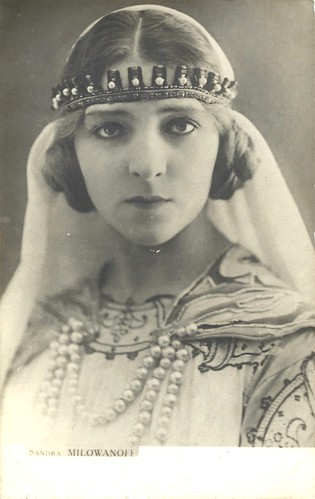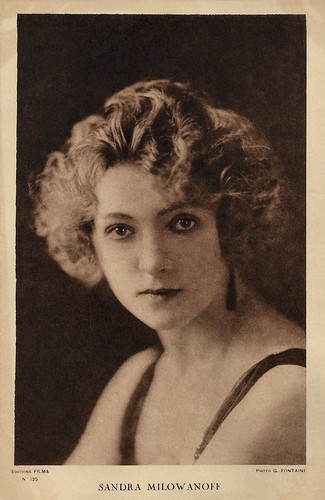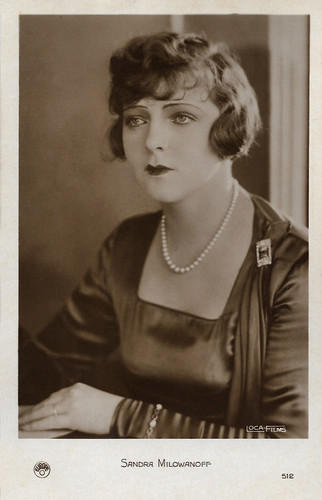
French postcard. Photo: Film Gaumont.

French postcard in the Les Vedettes de Cinéma Series by A.N., Paris, no. 75. Photo: G.L. Manuel Frères.

French postcard in the Les Vedettes de Cinéma Series by A.N., Paris, no. 185. Photo: G.L. Manuel Frères.

French postcard by Editions Cinémagazine, no. 403.
Fascinated by her beauty
Sandra Milowanoff was born Alexandrine Aleksejevna Milovanova in Saint-Petersburg, Russia, in 1892, and she was the daughter of Alexis and Marie Milowanoff. She already dedicated herself to dance at a young age and entered the Corps de Ballet of the famous Anna Pavlova. She was a great success as Princess Aurora in Ivan Vsevolozhsky's and Pyotr Ilyich Tchaikovsky’s ballet Sleeping Beauty (French and Italian Wikipedia incorrectly write ‘in the role of Anna').
After a triumphant tour of various European capitals, Alexandrine left her homeland in 1917 to escape the October Revolution. Her family found shelter in Monte Carlo. While looking for work, she got a small part in a film by René Hervil and Louis Mercanton, La p’tite du sixième/The Little One of the Sixth (1917) with Lillian Hall-Davis.
Fascinated by her beauty, director Louis Feuillade gave her a leading part in the 12-part serial Les Deux Gamines/The Two Girls (1921). Together with Olinda Mano, the child actor from Feuilllade’s Judex, Milowanoff played the two title characters. Also in the cast of this Gaumont production were Blanche Montel, Georges Biscot, Edouard Mathé, Fernand Herrmann and a debuting, young René Clair.
This serial proved to be a massive success, and Feuillade cast Milowanoff and the rest of the cast again in three other 12-part serials: L’Orphéline/The Orphan (1921), Parisette (1921) and Le fils du filibustier/The son of the financier (1922). The male lead in Le fils du filibustier was Aimé Simon-Girard, by then the dashing hero of the successful series film Les Trois Mousquetaires/The Three Musketeers (Henri Diamant-Berger, 1921).
Sandra Milowanoff played again the female lead in Feuillade's feature Le gamin de Paris/The Kid of Paris (1922) with former child star René Poyen and the new child actor Bouboule. It was the last time Milowanoff worked with Feuillade.

French postcard in the Les Vedettes de l'Écran series by Éditions Filma, no. 125.

Vintage postcard, no. 31-1.

Vintage postcard, no. 31-2.
Les Misérables
From 1923 on, Sandra Milowanoff became a regular actress for director Jacques de Baroncelli, who cast her in his drama Néné (1923) with France Dhélia, in the title role of La légende de soeur Béatrix/The Legend of Sister Beatrix (1923), La flambée des rêves/Soaring dreams (1924) and in particular the Pierre Loti adaptation Pêcheur d'Islande/Island Fishermen (1927), filmed in Brittany.
In Pêcheur d'Islande/Island Fishermen (1927), Milowanoff played the tragic protagonist Gaud opposite Charles Vanel. Vanel played the fisherman Yann who is in love with Gaud, the sister of his best friend Sylvestre (Roger San Juana) but is too proud to ask for her hand in marriage.
Milowanoff also played female leads in Jocaste (Gaston Ravel, 1924) starring Thomy Bourdelle, and Le Fantôme du Moulin-Rouge/The Phantom of the Moulin-Rouge (René Clair, 1925) starring Albert Préjean. Henri Fescourt gave Milowanoff the double role of Fantine and her daughter Cosette in Les Misérables (1925), based on Victor Hugo’s classic novel. This 4-part historical drama starred Gabriel Gabrio as Jean Valjean and Jean Toulout as Javert.
Milowanoff's career remained highly successful throughout the silent era. She played in Mauprat (Jean Epstein, 1926), a lavish costume drama set in pre-Revolutionary France, adapted from a novel by George Sand, and with Maurice Schutz in a double role.
Other films were Les larmes de Colette/The Tears of Colette (René Barberis, 1926) with Paul Jorge, and the romantic drama La proie du vent/The Prey of the Wind (René Clair, 1927) starring Charles Vanel.

Vintage postcard. Sandra Milowanoff in the title role in La légende de soeur Béatrix (Jacques de Baroncelli, 1923).
With Aimé Simon-Girard. French Postcard, no. 171. Photo: Gaumont. Collection: Didier Hanson.

French postcard for the Gaumont serial L'Orphéline (Louis Feuillade, 1921), starring Sandra Milowanoff.
A virtuoso masterpiece
Then Milowanoff embarked on an international career. She first acted with the Spanish director Benito Perojo in La condesa Maria/La comtesse Marie (1927) with José Nieto, then with the German director Felix Basch in Da hält die Welt den Atem an/Make Up (1927) with Marcella Albani and Werner Krauss, and next with the Swedish director Gustav Molander in Förseglade läppar/Closed lips (1927) with Fred Louis Lerch and Mona Märtenson.
Curious is that some of these French, as well as international productions, were Albatros (co-)productions, while Milowanoff did not act in the earlier productions of this studio in which Russian actors and directors were so prominent. After her international adventures, Milowanoff returned to France to act in La veine/The vein (René Barberis, 1928) with Rolla Norman, La faute de Monique/ Monique's Fault (Maurice Gleize, 1928) with Rudolf Klein-Rogge, and La meilleure maîtresse/The best mistress (René Hervil, 1929) starring Tramel.
Her last silent film was directed by Charles Vanel, Dans la nuit/In the Night, which co-starred Vanel and Milowanoff. The film is now recognised as a virtuoso masterpiece, especially after its restoration and relaunch in 2002. Critic Guillemette Olivier-Odicino in Télérama compared Vanel's style with his daring framing, editing and mobile framing to that of famous directors like Jean Renoir, Jean Gremillon and Georges Franju. But in 1928, Dans la nuit came out in France at the same time as the sensational first sound film The Jazz Singer, and Dans la nuit was completely ignored. After one more film in 1932, Vanel quit film directing altogether.
When sound cinema set in, Sandra Milowanoff stopped film acting. In the 1940s she came back and acted in a handful of films. These were only minor parts. The best-known of these films is Le comédien/The Private Life of an Actor (Sacha Guitry, 1947) in which she played a Russian servant. In 1950, she quit the screen definitively.
Almost completely forgotten, Sandra Milowanoff died in Paris in 1957. She was 64. She lies buried at the Pantin cemetery in Seine-Saint-Denis.

French postcard by Editions Filma, no. 125. Photo: G. Fontaine.

French postcard by Editions Cinémagazine, no. 114.

French postcard by Europe, no. 512. Photo: Loca-Films.
A scene from Dans la nuit/In the Night (1929). Source: Saskia (YouTube).
Sources: Ann Harding's Treasures (French), Ciné-Ressources (BiFi), Allo-Ciné, Filmportal.de, Wikipedia (French, Spanish and Italian) and IMDb.
No comments:
Post a Comment